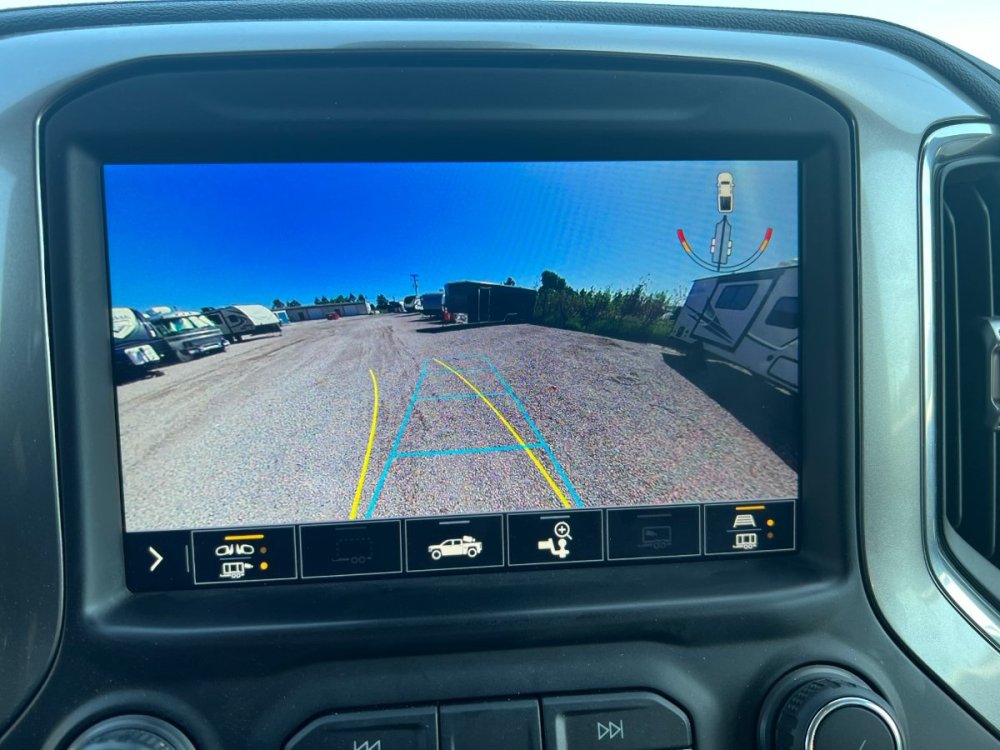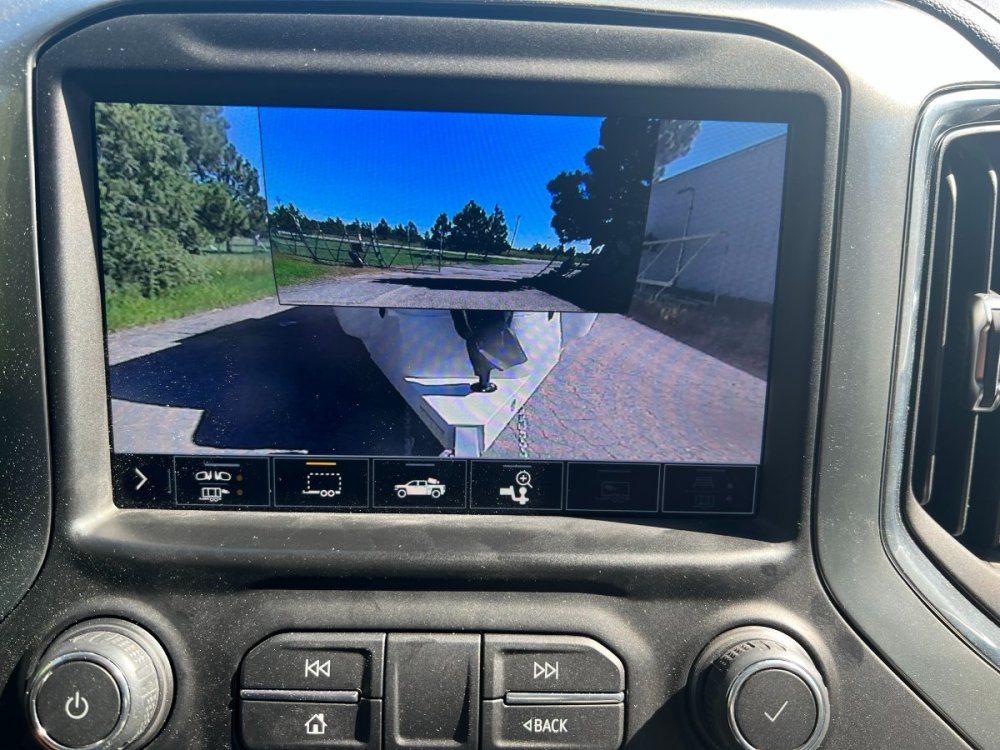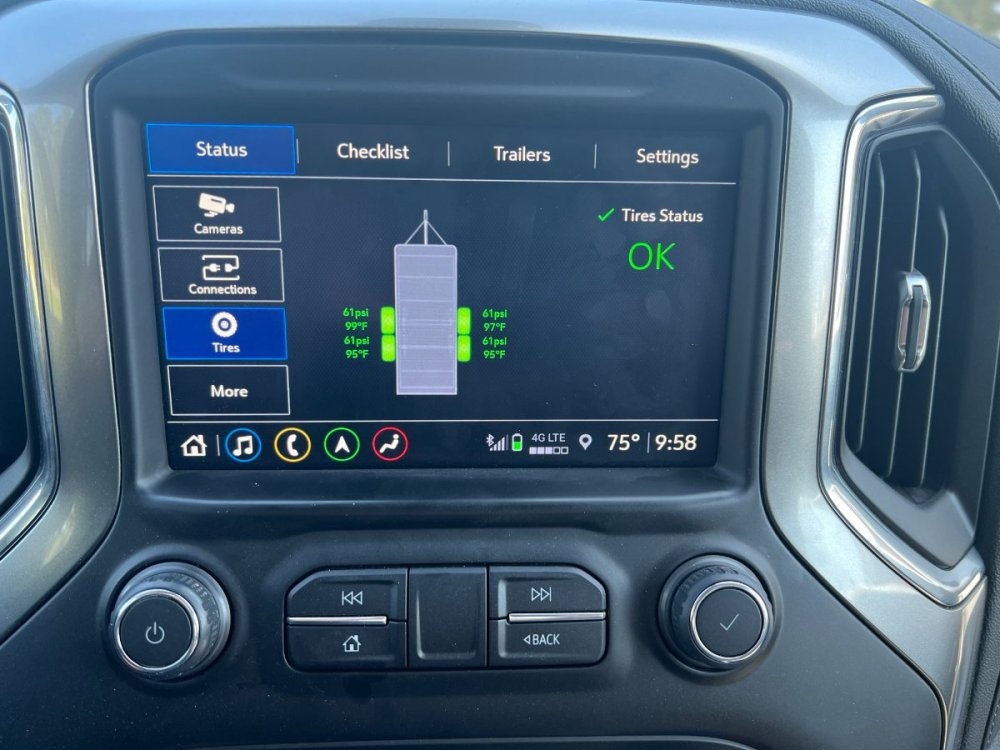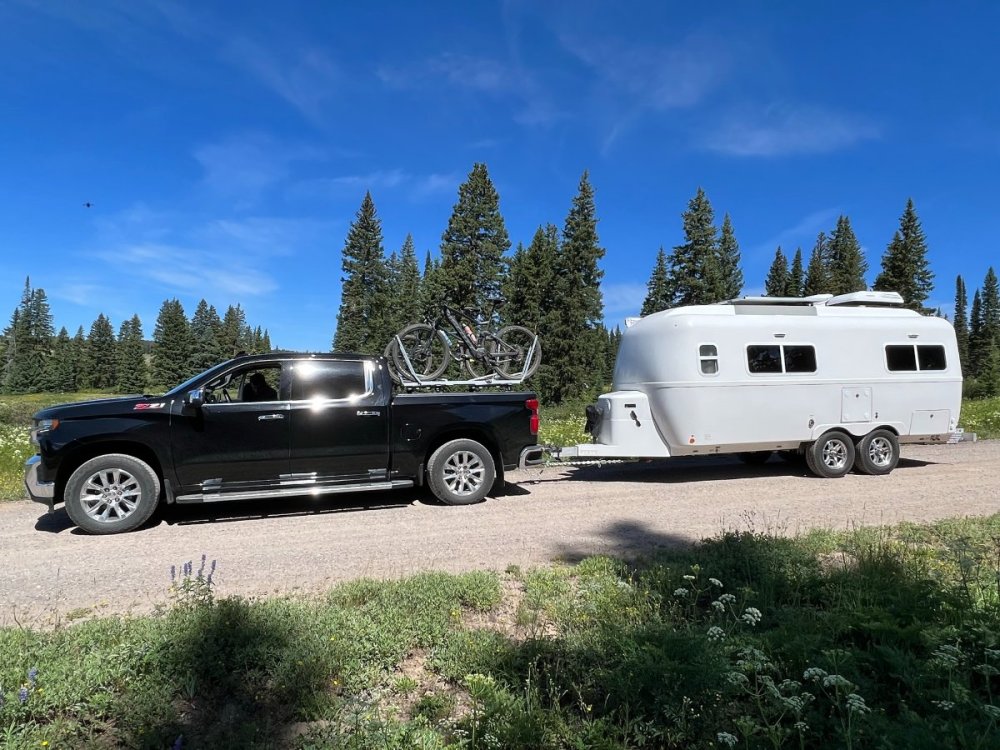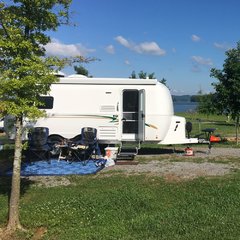Search the Community
Showing results for 'tpms'.
-
I've commented in a few different threads about my experience towing with my 2021 Chevy Silverado 1500 3.0L diesel. In 2.5 years, it now has 32K miles and about 5k towing my LEII. I thought I would post a follow-up that may be helpful for anyone considering the GM half-ton diesel as a tow vehicle. After owning Toyotas for almost 20 years, I have to say I was hesitant about the reliability of a GM product -- but it's been great so far. PROS: Power/torque more than adequate for towing an LEII. I just returned from a trip that took me over Loveland Pass, Rabbit Ears Pass and Berthoud Pass in Colorado. The diesel engine has absolutely no problem and no stress getting up and over. No noticable loss of power at high altitude and no high-RPM downshift that can happen with a gasoline engine. Fuel economy has been very good. I average 17 mpg while towing and the truck gets around 30 mpg in highway driving when not towing. In Colorado, diesel is now a little less expensive than regular again (yay!) but a year ago it was more per gallon so that wiped out any significant savings. 10 speed transmission is super smooth Automatic engine brake is fantastic on the long downhill runs. It's very reassuring to have it kick-in automatically and only touch the brakes a few times. I've always felt stable and in-control - even rolling all the way down Loveland pass at speed with traffic! GM trailer tow package and 360 degree camera package is excellent. It recognizes and remembers my trailer. It checks and notifies me of a wiring fault (I still check my lights/brakes manually). I purchased and self-installed the GM accessory trailer rear-view camera and it works extremely well. The live-motion back-up guidelines are super helpful (see photos). The truck monitors the TPMS sensors in my Oliver tires (had the GM sensors installed) and it displays on the dashboard screen. Comfortable and quiet ride both while towing and when being used as my daily-driver. You can barely tell its a diesel engine as there is almost no "clack" sound No problems in 32k miles so far CONS: Payload is around 1500 lbs (like all half-ton trucks) and that could be limiting for longer trips and taking more "stuff" Have to use the WD hitch (like all half-ton trucks). I find the Anderson WD hitch to be a hassle - but one that I can live with to be safe and legal. Squat from trailer tounge weight was not bad but a little more than I liked. I added Roadmaster Active Suspension (RAS) and this reduced squat by about an inch without any noticible effect on ride quality. Have to mess with adding DEF fluid. When towing, it uses a lot of DEF and the guage is not very accurate. Best to top off before leaving and/or put an extra 2.5g of DEF in the bed to minimize anxiety about it. Maintenance may be a little more expensive. I only trust the dealer to do the work as independent shops may not be familiar with the 3.0L Duramax. Oil changes cost $120 every 6K to 7K miles. Overall, I'm very pleased with my decision to buy the truck as my TV and as my daily-driver. I would buy this truck again and defintely get the 3.0 diesel over the 5.3 or 6.2 gas engines. If I were more of a full-timer in towing, I would consider spending the extra for a 3/4-ton. This would be primarily so that I had more payload and to avoid the WD hitch. Hope this may be helpful for anyone considering the GM half-ton diesel truck.
- 5 replies
-
- 13
-

-

-
GM 1500 Truck w/3.0L Diesel - follow-up @32k miles
Cameron replied to tallmandan's topic in Towing an Oliver
I continue to be happy with my 2020 AT4 1500 with the 3.0. I have about 50k miles on it now. I use it as my daily driver in San Francisco with lots of stop and go. City driving only gives me about 15 mpg. I'm actually on a cross country drive now without the trailer. I set the cruise control at 80 mph on I-80 and am getting 24 mph. I've pulled the Ollie for about 4,000 miles and never had a problem, also getting about 15-17 mpg when towing, depending on speed. Plenty of power, super smooth, and I don't use a WDH. Overall, it's great. But, there are a few little things that bug me such as: gotta put DEF in, the motor oil is more expensive than oil for gas engines, it does burn a bit of motor oil which GM says is normal (all engines burn some oil?), diesel in the last couple years has been more expensive. Ditto on the rear camera (GM OEM) mounted on the rear of the Ollie and the trailer TPMS (also GM OEM) that are integrated into the truck's software. -
GM 1500 Truck w/3.0L Diesel - follow-up @32k miles
Allen Lee Rohner replied to tallmandan's topic in Towing an Oliver
I agree with you comments. Have the 3.0L Diesel in my 2022 GMC Sierra 1500 AT4, CarbonPro. The motor has plenty of power. I think the 3.0L Diesel would handle 3/4 ton. I am very happy with my truck. 19,500 miles 4600 miles towing LEII 15 mpg w/heavy foot The GM TPMS is a plus. -
Search doesn't do much usually, but in this case it gets a bunch of hits: https://olivertraveltrailers.com/forums/search/?q=TPMS&quick=1 https://olivertraveltrailers.com/forums/topic/2482-review-tire-traker-tt-500-tpms/ After more than four years I still like it. I "flick" each transmitter in the morning before I leave camp to wake them up, that way the monitor will show the current cold pressure, not the hot pressure from the last time it was on. This is not possible with internal automotive type sensors. They will show you the correct pressure as you drive away, after a minute or so. Be sure to add one to the spare tire also. Install a short spare tire extension air hose and you won't have to remove the tire to add air. Definitely buy a TPMS, you will be much less stressed on the road, especially when you are far from services. John Davies Spokane WA
-
TPMS-Are most of you using tire pressure monitoring systems? Anyone have good or bad comments about specific brands?
-
This is odd. I lost my little IR thermometer when we picked up our Ollie and recently replaced it. I'm in the habit of checking the brake drum temps when we reach our destinations. On the last 2 trips my passenger side brake drums were registering 20-30 degrees higher than the driver's side drums (as measured through the wheel spoke openings). Here's the weird part. The driver's side and passenger side drums are different from each other, but consistent with their partner on the other axle on that side - within just a few degrees. For example, the driver's side drums might be 120 and 124 degrees, while the passenger side are 149 and 146. The first time I thought it was because the passenger side was in the sun for most of the trip, but that wasn't the case last time. TPMS reports all tires running about the same temp. We just had axle service due to a recall and I watched the tech do it. No inconsistencies there. The brakes are auto-adjusting Dexter. Steph has walked alongside the trailer while I'm moving it, listening for odd sounds, but nothing. The only thing I can think of, and this is a real reach: the passenger side airflow might be affected by the step box and those drums cool slower???? On our last trailer there was one drum that always ran a bit hotter than the other 3. Figured that one brake adjusted itself a little tighter than the others, but I've never seen this happen in pairs on different axles before. Very strange.
-
I purchased the TireMinder i10 system with 6 sensors (I second the recommendation by @topgun2 to purchase 5 sensors). I am happy with the system, which has a small monitor which I keep in the console of the TV when towing. The monitor sounds an alarm to alert of problem conditions. TechnoRV.com is a good source. On the recommendation of @John E Davies, I also purchased two extension hoses to attach to the spare tires on our LEII and TV, Cheme Extension Hose, Air, 36" (2). In addition, I purchase a pair of valve stem extensions, Mellbree 2-Pack Tire Valve Extension, 90 Degree Schrader Tire Valve Stem Extension. These additions have proven to be quite beneficial, as the spare on the LEII is mounted with the valve facing the trailer body, requiring removal of the spare to adjust the air pressure. Our TV also stores the spare with the valve facing down, requiring removing the spare from its storage well to adjust the air pressure. In both cases this PITA is eliminated by having the extension hose installed with the TPMS sensor at the end and accessible. Don
-
Im looking to add TPMS to Ollie. What brands are reccommened?
-
That's a significant advantage of your TSP TPMS! Something to verify before purchasing a TPMS for sure.
-
Timely topic, just went through this on both my TV (F150) and the Elite II. Had Les Schwab install the Vredestein LT Pinza AT's on both units but here's the odd part. They insisted on keeping the PSI on truck the same as the door sticker which was 35 front and rear but a week later when they installed the same tire on our Oliver they ran them at 80 PSI. WTF, go figure. I am currently running the truck at 45 PSI and Oliver also at 45 PSI. There just isn't enough load within the Oliver to run them at a higher PSI IMO. Also worth pointing out, after getting both sets of tires installed I also ordered a TPMS. Initially installed them on the truck, took a 60 + mile drive on the interstate and while it was a mild day 70's for temps at no time did the PSI increase more than 5 points. Consistently the tires on the side that faced the sun ran 1-2 PSI higher than the shady side. Granted I was not carrying a load and it was not hot temps but thought it to be a fairly good indicator of adequate PSI for the truck. For those who would like to delve into this more can't recommend the following link enough: https://tirepressure.com Lots of excellent information, calculators etc on this website regarding tire pressure for all vehicles and types of tires.
-
Also, a TPMS will let you know right away what your pressures are!
-
I am in the process of installing a Tire Pressure Monitoring System on my trailer and truck. There is lots of chatter on the forums reccomending the installation of metal valve stems. Some say the TPMS on the top of the valve core extends the TPMS out enough to possibly damaging the stem when coming too close to curbs, so reduce the damage by changing from rubber to metal stems. However, there is equal chatter reccomending not installing metal stems because of the chemical reaction of dissimilar metals. Some say it is rust from salt on the roads. Several say that once the reaction begins to occur, removing the TPMS to put more air in is difficult and may damage the TPMS and/or the stem. No matter, it gives me pause to change out the rubber stems to metal ones. What say you???
-
I have the Ford accessory trailer camera, but no Oliver yet. The camera comes with a wire harness the runs from the trailer camera to the video plug at the bumper. It will be a direct feed to the dash screen. This is a sample picture provided by Ford for the view on the dash from the Trailer cam: Ford also offers TPMS sensors for the trailer as well that integrate on the dash with the truck TPMS system. They can all be ordered in the same kit.
-
Most certainly there are probably differences between the manufacturers of these TPMS systems. But, it is also fairly likely that the basic systems are similar. In the case of the EEZ TPMS their website states the following: "Tire pressure sensors are directly mounted on tire valves and transmit tire pressure and temperature information to TPMS monitor on a 6-second interval continuously even when vehicles are not moving. TPMS monitor is motion sensitive and will go into power saving mode if no motion is detected in 15 minutes to save battery."
-
@routlaw: We found this unit on Amazon for what we consider a fair price point, much less than what we invested in the first TPMS go around: We've got roughly 500 miles of usage so far without issue. The readout is smaller than my old eyes would like, but it's solar powered and doesn't need 12vDC unless it's not been used for several weeks. It charges through a USB cable in about 25-30 minutes time. But as mentioned above, sensor batteries are a piece of cake to replace. Just my $0.02 worth... Stay safe, brother...
-
Good info regarding the type of TPMS and batteries @MAX Burner well noted. What are brands worthy of consideration then?
-
Use that TPMS on your trip to the Rally. Keep a very close eye on the tire temps and pressure. If you have anything approaching or over a 10 psi increase in tire pressure it could mean that your tires are underinflated. Remember - it is high tire temp that kills most tires and generally degrades a tire from the inside to the outside. Obviously, you must also keep in mind other conditions such as the road surface (a concrete surface will generally be cooler than a black top surface), the "crown" of the road (the tires on the lower side of the crown will generally run a bit warmer than the tires on the high side), the sun ( the tires on the side of the camper that are in the sun will run hotter than those in the shade), etc. Also keep in mind that the tire temps you should be most concerned with are the "cold" tire temps. That is your base line. Tire manufacturers allow for the natural increase in tire pressure in the construction of the tire. Even when a tire that has a maximum pressure rating of 80psi (cold) goes over that pressure during "normal" operation it is (most likely) within design specifications. Bill p.s. Have a safe trip over to the Rally! Can't wait to say hello!
-
It is my understanding that there are a number of TT electronics that may utilize the "433.92 Mhz" band (a wireless radio band on which compatible household (substitute TRAILER) devices send signals. i.e. RVLOCK Key FOB, and TPMS systems. I am wondering if anyone out there has had problems/issues with anything that you have added/installed "After OTT Delivery"? B~Out
-
I am installing a TPMS Signal Booster in the Propane Tank compartment. Where should I attach the positive red wire and the negative ground wire? Should I incorporate a switch. Is there any documentation from Oliver for the junction box behind the rear jack controls?
-
We've added, Main Hatch lock/remote, LGP tank w/remote readout, TPMS, SmartShunt w/BT, and a 100Watt HAM radio - no problems noted, FYI.
-
I have the electronic door keypad with remote fob, the awning remote control, the MaxAir fan remote, and also a TireTraker TPMS system (installed after delivery) and so far no problems that I’ve noted.
-

Article on how TPMS sensors operate
GraniteStaters replied to John E Davies's topic in Mechanical & Technical Tips
We have a Tuson TPMS system with internal TPMS and it is installed in our LEII tires and spare and is very good. They provide a transmitter for the trailer if it is longer than 18 feet as I recollect. I installed it too. I was curious on how it reads the spare and was pleasantly surprised to get the info when the trailer is moving. I purchased the activation tool from them to ease the configuration for the spare’s TPMS which was purchased separately. The activator sends a signal to the TPMS that simulates a pressure drop. Alternatively without this tool, I would have had to bleed air from the tire. I opted for the tool. It ended up being important for me to use on the other TPMSes installed so I could get all the tires displayed in the right order.- 1 reply
-
- 2
-

-
"If your Expedition is not completely up to date on maintenance, get that done in the next month. Change drive train fluids, make sure the tires and brakes are fresh and good, have a load test done on the battery. A five year old battery and tires are “aged out” and more likely to fail. It is best to change them rather than have to deal with a failure in the middle of nowhere. Have the entire vehicle looked over before your momentous looong road trip. Buy a TPMS for the trailer and install it promptly, and make sure your Ollie tires are set to around 50 psi at most." The tires are new, maintenance up to date. Battery is new. Good advice to have the Expedition looked at as you suggested. I do have a tpms. I think that's a must have. Thanks for all the suggestions. Thanks also for making your enclosed storage area big enough for two Olivers. That was great foresight! Glad we don't live that far from you. 😂🤣 John
-
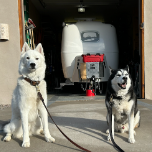
getting ready to camp after 2 yrs in storage
MAX Burner replied to LindaShields's topic in Introduce Yourself
If you haven't already done so, consider putting an IR temp gauge on your list of Ollie items to bring along - so you can check tire and drum temps along the way.... just say'n. A TPMS is another consideration, unless you've already got one.


